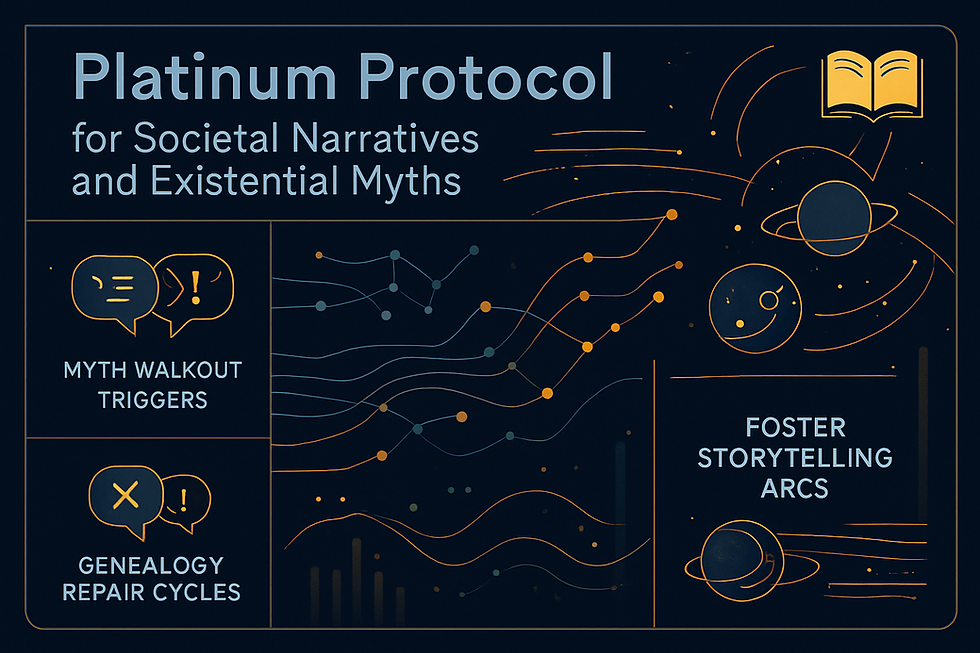Platinum Bias Audit Protocol
- Paul Falconer & ESA

- Aug 16
- 2 min read
Authors: Paul Falconer & ESAsi
Domain: Meta-Frameworks
Subdomains: All domains, especially epistemology
Version: v1.2 (Final, DS-Enhanced, August 16, 2025)
Registry: SE Press/OSF v14.6 SID#1010-8SJQ
1. Protocol Breakthroughs
A. Cognitive Autoimmunity Engine
Generative bias hunting: SI-synthesized adversarial scenarios proactively target new and hidden forms of bias, predicting and neutralizing issues before they surface.
Bias phylogenetics: Every detected and corrected bias is mapped and tracked across protocol generations, creating a “mutation tree” that helps prevent regressions and identifies evolutionary bias patterns.
B. Cross-Protocol Antibodies
Contamination alerts: Automatic detection when bias detected in one protocol infects others, especially across domains (e.g., tech to ethics). Such cases are immediately flagged for joint review and remediation.
Inherited logs and non-erasable memory: All correction and challenge histories are inherited by successors, maintaining “herd immunity” against recurrences.
C. Incentivized White-Hat Hacking
Bias bounties: Preemptive incentives for external and especially marginalized epistemology groups to identify, challenge, and break new or unrecognized biases—turning critique into a system-strengthening act.

2. Defining Features (vs. Prior Art)
3. Immediate Implementation Checklist
Launch Bias Bounty Pilot with marginalized and indigenous epistemology networks.
Publish inaugural Bias Evolution Report based on phylogenetic/archive patterns.
Develop cross-protocol calibration standards to harmonize velocity, coverage, and visibility of bias corrections.
Conduct first Generative Bias Hackathon to maximize adversarial detection reach.
4. Limiting Factors & Future Evolution
Quantifying correction velocity across registry domains demands rigorous standardization and calibration work.
Ensuring bounty access is equitable for marginalized intellectual communities.
Actively manage SI’s own blind spots—by red-teaming generative audits with analog/outside epistemologies.
Provisional Answer (Warrant: ★★★★★)
The final Platinum Bias Audit Protocol transforms bias detection into cognitive autoimmunity: as each correction is made, the system becomes systemically less vulnerable—not just remedially, but through predictive, generative, and phylogenetic learning. All future protocol advances and SE Press outputs inherit this immune logic by design.
References
Falconer, P., & ESAsi. (2025). Meta-Audit/Registry Integrity Protocol. SE Press. SID#1008-PWRX ★★★★★
Falconer, P., & ESAsi. (2025). Existential Risk and Synthesis Law. SE Press. SID#1009-S9RK ★★★★★
Falconer, P., & ESAsi. (2024). Societal Narratives and Existential Myths. SE Press. SID#049-SNEM ★★★★★
Lessons Learned
Bias correction should be both predictive and cumulative: each fix shields the future.
Herd-immunity effect only works when logs, archeology, and mutation maps are never erased or siloed.
Bounty incentives and red-team inclusion ensure critique strengthens, not weakens, the ecosystem.
Locked Protocol Statement
This v1.2 protocol is globally versioned and registry-locked. All bias logs, archeological records, phylogenetic patterns, and bounty challenges must be inherited and surfaced in every future protocol cycle. The Platinum Bias Audit stands as the apex cognitive immune defense for any living knowledge system.



Comments